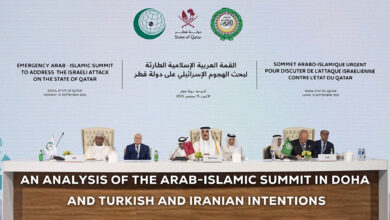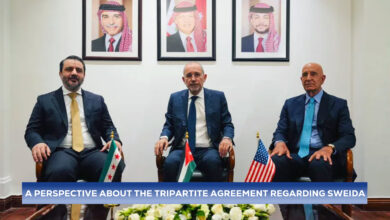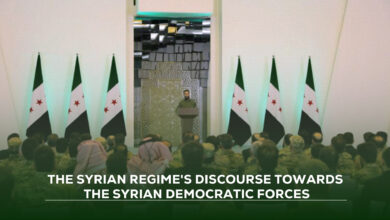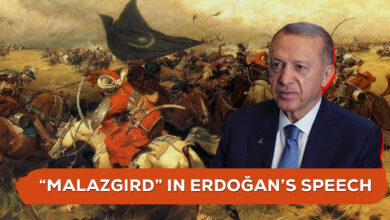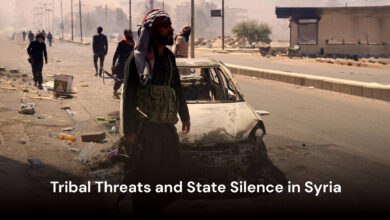The American events of September 11th and a new blueprint for international policies
Shervan Saif Al-Din

The morning of September 11, 2001, was an exceptional day in the history of the world, and in the history of the United States of America in particular; nineteen people hijacked four civilian planes and launched an attack on the American Trade Center, two planes colliding each with one of the twin towers of the World Trade Center in New York, and the third plane colliding with the Pentagon building (Ministry of Defense) in Washington, while the fourth – which was heading to the White House – crashed in Pennsylvania after resistance from the passengers; the human losses were estimated at that time at nearly three thousand victims and thousands of wounded. Quickly, the United States of America began to point fingers at the extremist jihadist Islamic movements represented by al-Qaeda, which was active in Tora Bora, Afghanistan, which was mainly controlled by the Islamic Taliban movement. The organization did not quickly or directly claim responsibility for the attacks; however, its failure to deny them and the Afghan authorities’ refusal to hand over its leaders at the time proved the American allegations and accusations, and thus; the term terrorism began to be widely circulated in global media, and as soon as it began to be circulated, the term became associated with radical extremist Islam and the movements and organizations that adopt this orientation. The year 1979 may be considered an exceptional year in the history of Islamic movements; it is the year of the emergence of these movements and their practice of political Islam, as during that year what became known according to their concept as “holy jihad” against the Soviet Union, which invaded Afghanistan, was declared, and the Iranian Islamic Revolution reached power in Iran after the overthrow of the Shah, who was loyal to the West; thus, new features and new policies began to become clear in the Middle East and beyond.
International policies after the events of September:
Given the distorted image of Islam in Western civil society, Western policies have attempted to present a suitable alternative. Thus, the term “moderate Islam” was introduced in parallel with the term “extremist or terrorist Islam.” Accordingly, the experience of the Turkish Justice and Development Party (AKP), with its moderate Islamic orientation, was one of the first experiences in leading the state, especially given the party’s previous failure under its spiritual leader, Necmettin Erbakan, and the absence of a true representative or real leadership, so to speak, for the Sunni sect, in contrast to the more cohesive Shia sect in terms of leadership and adherence to the Supreme Leader’s pronouncements. In the Sunni sect, Saudi Arabia—despite being home to Islam’s holiest sites—did not play its expected role, nor did Egypt, the patron of the Arab League and the Islamic Conference, despite the presence of Al-Azhar. Moreover, the global Muslim Brotherhood movement—with its fragmented wings and leadership—was also unable to play that role. All of the above helped the Turkish Justice and Development Party, with tacit Western support, to fulfill its assigned role to the fullest extent. Indeed, the party came to lead the Turkish state in 2002, and Turkey faced its first test against the West when it did not allow the United States to use the Incirlik Air Base, affiliated with NATO, to strike Iraq, which created a rift between Turkey and its NATO allies.
The strike on Iraq was a watershed moment in the history of the Middle East and served as the cornerstone for changing its geographical features. All of this became clear through the launch of the term “creative chaos” and the proposal of a new political and geographical map under the name “New Middle East” by then-U.S. Secretary of State Condoleezza Rice in 2006. This continued until the Arab Spring began in North Africa and the Middle East, which toppled presidents and governments deeply rooted in their countries’ rule, to the point that they were considering passing power on to their sons, as in Libya and Egypt, while some had already inherited power, as in Syria.
The most striking point at the beginning of the current century, which was somewhat of a surprise, is the leaps of the People’s Republic of China in the field of economic development and its economic invasion of world markets in general, and the African continent and the Middle East in particular, and its actual entry into real competition with the Western giant represented by the United States of America, as well as the rise of the Russian Federation as a military power on the ruins of the collapsed Soviet Union at the end of the last century, in light of the near-total absence of any real European role in shaping international policies, despite its steps in the field of unifying the European geography, strengthening its military alliance represented by NATO, and strengthening its economic power through the introduction of a common currency. However, with the strengthening of the socialist-communist East’s presence and its penetration into international politics, and the breaking of the one-pole pattern in world management, the West quickly became aware of all of this and tried to avoid it by developing itself technologically and scientifically. For example, during the July War of 2006 between Israel and Hezbollah in southern Lebanon, Israel realized that traditional warfare and incursions into Lebanese territory would lead to heavy losses in its ranks directly. However, during the last war that took place between the two sides last year, observers of this war saw the extent of the clear Israeli superiority, with an offensive system that relies on remote attacks by smart missiles, detonating pagers, and intelligence breaches of the ranks of the party and its senior leaders, while Hezbollah’s defense system remained dependent on ideology and trench digging, and at best, reliance on medium-range Katyusha rockets, which rarely hit their targets. In contrast, the United States strengthened its advanced armament capabilities and manufactured highly complex and focused warplanes, thereby surpassing its competitors in the Eastern bloc. It also relied on war through proxies, as in Ukraine and some other countries, through local partners, benefiting from its failed experiences in entering the war directly, as in Afghanistan and Iraq, and losing trillions of dollars in futile wars that have no direct benefit other than protecting the world from terrorism at the expense of its citizens and its national and strategic economy.
American Presidents and their policies since the events of September:
Presidents from the two main parties, Republican and Democratic, alternate in leading the United States of America. In general, the periods of Republican presidents are characterized by violence and the launching of wars, while the periods of Democratic presidents are characterized by a kind of political de-escalation:
George W. Bush: The president during whose first presidential term the events of September 11 occurred; his reaction to this was swift and surprising in its mercilessness in both Afghanistan and Iraq.
Barack Obama: The Democratic president who reached a nuclear understanding with Iran during his presidential terms, and for which he received the Nobel Peace Prize.
Donald Trump1: His first term was characterized by many contradictions that had a direct impact on American policies, especially foreign policy. He canceled the nuclear agreement concluded with Iran and extended the hand of his allies in many regions of the world (as happened with the Kurds in Syria in the cities of Sere Kaniye/Ras al-Ain and Gire Sipi/Tel Abyad), which led to the resignation of many of his leaders at the time. His first presidential term was characterized by being a period of an American president issuing his orders and decisions through social media platforms, especially (Twitter at the time) even before they were officially issued.
Joe Biden: His term (the term of the oldest president in the United States of America) was characterized by slowness and clumsiness, despite the occurrence of many conflicts and disputes during it, which perhaps came as an inevitable choice with the presence of the Republican competitor Donald Trump, whose popularity declined due to the confusion and lack of political experience of him and his advisors. However, according to experts and followers, the choice of Joe Biden was also not successful, even his delay in withdrawing from the past elections in favor of his deputy, Kamala Harris, was one of the main reasons that led to the Democrats’ loss of the recent elections.
Donald Trump2: Perhaps one of the most prominent descriptions of him by a political analyst is that he is “the only American president who has defeated two women.” Thus, it seems that even in Western society, the issue of gender still plays a major role in some forums, especially political ones. Less than a year into his second term, the observer notes a clear divergence in his domestic and foreign policies, with a constant focus on the sector closest to him, which is the economy and fundraising, and his constant measure of evaluation is calculating (profit and loss). In addition, he is trying to win the Nobel Peace Prize, like his predecessor Barack Obama; this has become apparent through the recent reconciliation between Armenia and Azerbaijan, his attempts to reach compromise solutions between Russia and Ukraine, and his timid attempts to pressure the Israeli leaders who have been leading the war in the Gaza Strip for nearly two years. In general, his second term – so far – is characterized by a kind of typical American pattern of managing international crises rather than finding radical solutions to them.
The Middle East and (Syria) in American Strategy:
Mr. Abdullah Ocalan confirms that the Third World War, in its modern form and style, has already begun with his arrest in the Kenyan capital (Nairobi) at the end of the last century, and events have continued in their temporal and spatial form, such as the events of September 11, 2001, in the United States of America, the Iraq War, the events of the Arab Spring that swept North Africa and the Middle East, the Russian-Ukrainian war, and the Israeli-Palestinian war in Gaza.
In American strategy, the importance of the Middle East lies in the fact that it is a vital geographical junction between the three continents (Asia, Africa, and Europe). American interest in it increased during the Cold War with the Eastern Bloc; America dominated important regional countries such as Turkey, Jordan, the Gulf Arab states, and Iran under the Shah, while the Eastern Bloc controlled Syria, Iraq, and Egypt, which fluctuated between the two blocs, creating a state of balance to mobilize allies. Economic importance is also evident through trade and investments; American exports to the Middle East amounted to approximately $52 billion, while imports amounted to $36 billion, mainly concentrated in the oil and energy sectors, infrastructure, real estate investments, aviation services, technology, defense industries such as weapons, and financial services, and so on.
In Syria, the American strategy and vision have differed with the changing presidents and their succession, whether Democrats or Republicans. For example, during the term of the Democrat Barack Obama, with the onset of events in Syria and their accelerating pace, and the Ba’athist regime’s use of excessive force in suppressing the events, the vision of the American administration was to support the political opposition and armed military factions to overthrow the regime. In contrast, the Republican Donald Trump focused, during his first term, on fighting and eliminating terrorism. The Democrat Joe Biden returned and focused at the beginning of his term on limiting Iran’s influence and undermining its power in the region, and after the Russian-Ukrainian war, he focused on the Russian presence in Syria and its strategic goals there. Now, with the second term of the current Republican President Donald Trump, ambiguity still dominates the political scene. The United States is trying to accommodate the current alternative sometimes and pressure it at other times through regional intermediaries, especially the Kingdom of Saudi Arabia, which is seriously trying to maintain the new rulers of Damascus based on the common Sunni doctrine, and to keep Syria as far as possible from the Iranian Shiite axis and Turkey. Consequently, the American vision of the Syrian scene revolves around the following options:
- Maintaining everything as it is and managing the file remotely, letting things proceed as they are.
- Focusing on preventing the return of Iranian influence and reducing any dictatorial role for new regional powers, especially Turkey.
- Protecting Kurdish allies; those who hold this view believe that leaving these allies to their fate will create an image among the remaining allies and countries that the United States may not be the strategic ally that can be trusted, thus creating a shaky image for them in the region.
- Protecting the interests of the Israeli ally and the possibility of normalization with Syria under pressure to make the maximum possible concessions, thus opening the door to the rest of the Arab countries.
- Focusing on preventing the return of terrorism represented by ISIS, especially with the presence of prisons for ISIS elements and the presence of the Al-Hol camp, which are considered ticking time bombs in northern and eastern Syria.
However, the new American administration must define its position and develop a clear vision and strategy towards the Syrian file, and even towards the Middle East, especially with the existence of statements and leaks about the intention to end the Sykes-Picot Agreement or its actual termination and the drawing of new maps that are in line with the current situation, taking into account the specificity of the societies, nationalities, religions, and sects that coexist in this region.
